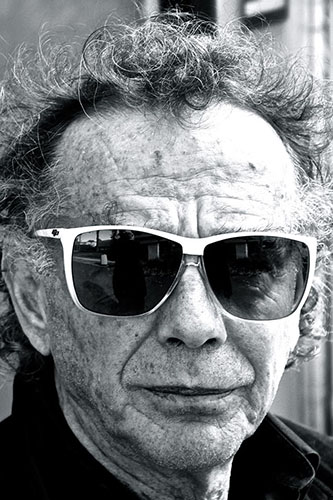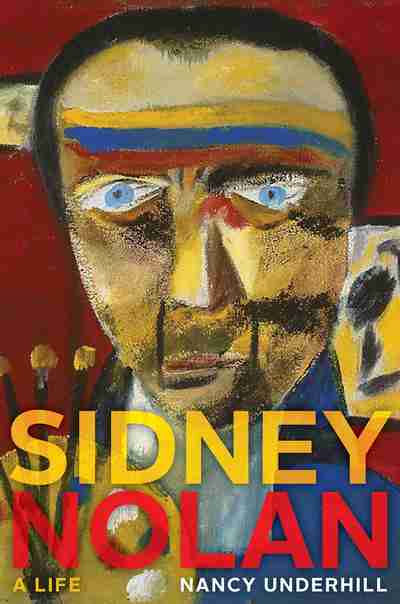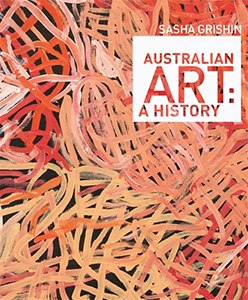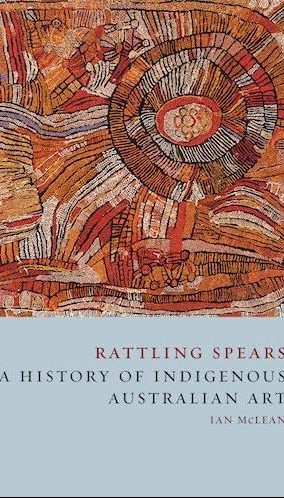‘Differant Curioes’:
Trans-Tasman art exchanges 1770-1970
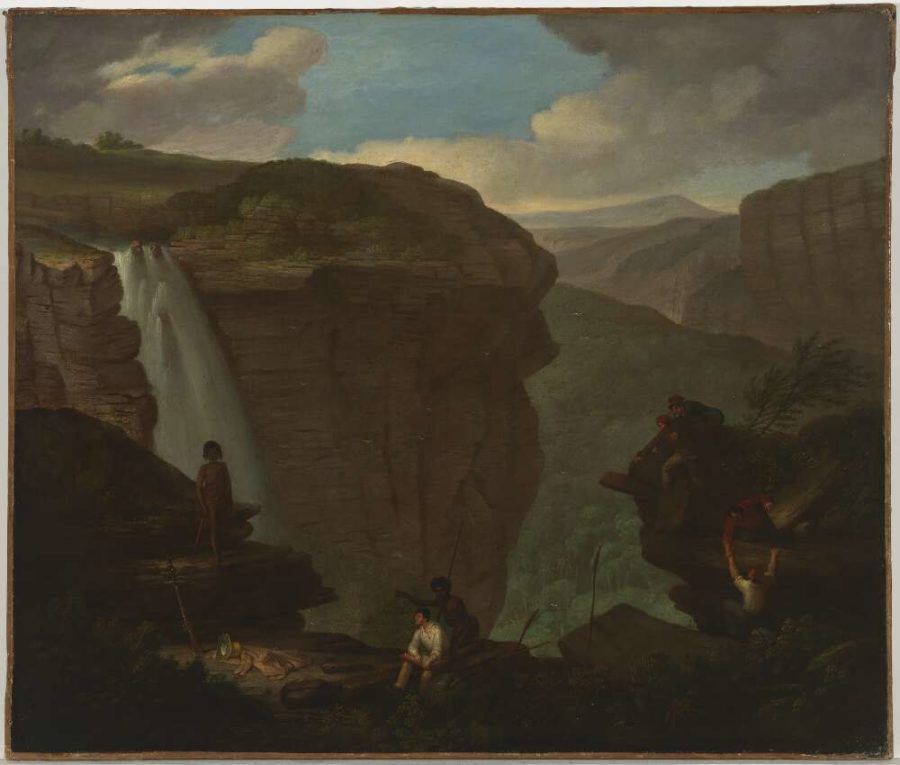
National Library of Australia nla.obj-134296148.
This is part of a series of essays co-commissioned by the SRB and non/fictionLab that foreground experimental approaches to the question of value in the sphere of arts and literature. ‘Differant Curioes’ is a companion piece to ‘A Glassy Sort of Rainbow‘ by Brigid Magner.
When scholar-librarian Anthony Murray-Oliver published his 1968 book about itinerant artist Augustus Earle, he illustrated all of the works known from Earle’s sojourn in New Zealand in 1827-8; but for the first plate chose a reproduction of the oil painting Waterfall in Australia. There was no clear reason for this, beyond the obvious one that it is a fine work; and, perhaps, that Earle had painted it before he departed from Sydney for Te Ika-a-Māui. However, as Hamish Keith pointed out in an acerbic review of Murray-Oliver’s book, there are no works in it from Brazil, nor Tristan da Cunha, nor Malacca, nor from any of the other places where Earle travelled and painted. So why this one?
Anyone who has looked into the nature of the trans-Tasman relationship would not be surprised by the anomaly. Incoherence, along with a lack of methodological rigour, is particularly apparent in most writing (not that there is much of it) about how practitioners in the visual arts in Australia and New Zealand have interacted with each other since James Cook sailed over the horizon in 1770. Cook carried artists aboard his ships, of course, as did most official expeditions of the eighteenth and nineteenth centuries; what makes Augustus Earle of interest, both in himself and as an ancestor, is that he was not an official artist. He was beholden to no-one: no patron, no employer, nothing to rely upon except his own resources as a painter, a writer and an entrepreneur.
Earle, born 1793 in Marylebone, London, into a family of American Tories, came to the antipodes serendipitously. In 1824, en route from Rio de Janeiro to Cape Town his ship, the Duke of Gloucester, a Margate hoy, stopped at the south Atlantic island of Tristan da Cunha to take on a load of potatoes; and, for unknown reasons, left the artist behind. During his eight months there he painted, drew, kept a journal, taught, hunted, conducted divine service and complained. There’s a work in which he shows himself, melancholy and alone (except for his dog Jemmy), stretched out on a craggy promontory looking over the grey sea. The ship that took him off, the Admiral Cockburn, was bound for Hobart Town. He spent some months in Van Diemen’s Land before going up to Sydney, where he became an enthusiastic participant in colonial society.
He decorated the dining room for Governor Brisbane’s farewell banquet in 1825; painted portraits of the great and the good; and opened an art school, which was also a gallery and a shop, at 10 George Street. He acquired a press and printed tickets for balls; designed scenery for theatrical productions; and made an edition of lithographic Views in Australia. He visited the Blue Mountains, the Wellington Valley, the Hunter River, Port Stephens, Port Macquarie and the Illawarra, where he broke his leg in a fall from a horse. His subjects included landscapes as well as portraits, many of Aboriginal people, both in their own country and on the streets of Sydney. They include his well-known painting of Bungaree in a cocked hat and a red military jacket.
When another projected inland journey was cancelled Earle decided to go to New Zealand instead. He sailed in October 1827 on the Governor Macquarie for the Hokianga then travelled overland to the Bay of Islands. There he recorded tales of cannibal feasts, the presentation of preserved heads as war trophies, the ceremony of mourning over bones, tattooists and tattooing, and much else besides. He lived with a local woman; and infuriated the Wesleyan and the Anglican missionaries with his accounts of their primness, hypocrisy and lack of generosity. During a skirmish at Kororāreka his house caught fire and he lost one of his two trunks of drawings, paintings, and art materials. He returned to Sydney on the same ship he’d come out upon and spent five more months there before sailing for India. He died, aged 45, ‘of asthma and debility’, in London in 1838.
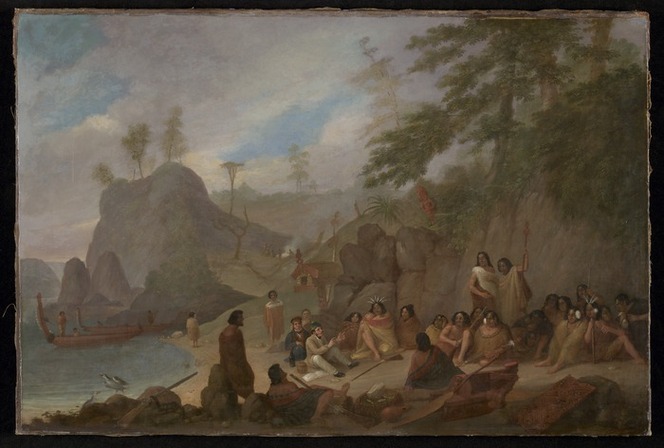
Alexander Turnbull Library ref: G-707.
Waterfall in Australia features a self-portrait near the centre of the composition; as does another oil painting Earle made of New Zealand. In the Australian work he shows himself in the act of making a picture, which we cannot see, of an Indigenous man posing on a rock before the cascade; another Indigenous man, standing behind the artist, gestures enigmatically towards the subject of the work. Behind them a group of four European men, perhaps convicts, are climbing, for an unknown purpose, upon a pile of rocks. Earle is half turned towards us, interposing himself before the spectacle of the waterfall and the ‘sublime’ landscape beyond. The man he is sketching was probably a guide, decked out in an approximation of traditional dress for the sake of the portrait.
The New Zealand painting is set on a beach in the Bay of Islands and shows the artist in conversation with a group of Māori, at whose centre is the titular ‘wounded chief Hongi Hika’. Hongi had been shot in the chest; the musket ball proved impossible to extract; he was dying. Earle has his sketchbook open on the ground beside him and both hands raised in a way that suggests he is explaining something. Again he’s half turned towards the viewer. His travelling companion, a Mr Shand, sits behind him. Someone amongst Māori must have been interpreting; possibly the statuesque, cloaked, vaguely Grecian figure in the foreground.
What is Earle is saying? Is he trying to sell something to Hongi? Or buy from him? In those days the most lucrative trade goods were guns and ammunition, often exchanged for so-called ‘baked heads’; Earle did have some muskets and a barrel of powder with him, but it isn’t likely they were part of this conversation. Perhaps he is describing the drawing – for which he asked, and received, permission to make – that he will later turn into a painting. What of the sketch of the Aboriginal man before the waterfall? Is the (notional) work one he will offer for sale in the metropolis? Maybe Earle was trying to exploit the then fashionable belief in the inevitable decline of Indigenous culture and the concomitant need to preserve its features for posterity?
Earle in these works opens up two different, and enduring, frames in which conversations between Indigenous people and their colonisers take place. In the Australian painting the focus is upon recording the lineaments of a representative figure of an ancient culture which was thought to be passing away. In the New Zealand work we see an exchange of views, suggesting that what we have here are representatives of two societies which, if not on equal terms, are still attempting to find some common ground. The differences between the two paintings might therefore also be taken as an index to the differing histories of the two country’s interactions with their respective Indigenous peoples.
Many artists followed in Earle’s footsteps, as if taking an antipodean version of the grand tour. George French Angas, for example, born at Newcastle-on-Tyne, the son of a carriage maker with investments in the South Australia Company, came out to Adelaide in the early 1840s to help manage his father’s business. He crossed the Tasman in 1844 and spent six months in New Zealand. Most of his subjects were Māori, whose portraits he painted and whose clothing, artefacts, dwellings and customs he recorded. He ranged widely through South Australia and New South Wales too. His aim, he said, was to describe faithfully impressions of savage life and scenes in countries only now emerging from a primitive state of barbarism. It was an ambition compromised by his sentimentalism; and his occasional plagiarisms.
Other wealthy and privileged European artists were drawn to Australia, especially after the gold rush in Victoria began in 1851. Johann Joseph Eugen von Guerard, for instance, Vienna-born, the son of a court painter, a trained artist who came out to the goldfields then lived in Melbourne for thirty years, while travelling frequently to New Zealand to paint. His grand landscapes partake, with scrupulous attention to detail, of the sublime. He was a teacher as well and may have had some (negative) influence upon members of the Heidelberg School. Von Guerard died in penury in London after losing all of his investments in the Australian banking collapse of 1893.
He is usually associated with Nicholas Chevalier, the St Petersburg-born son of a French Swiss diplomat at the court of the Tsar, and his Russian wife. Chevalier’s father had business interests in Victoria and, like Angas, Nicholas was sent out in 1855 to attend to them. They included a vineyard. He, like von Guerard, travelled and painted in New Zealand, mostly in Te Waipounamu, and at other times enjoyed the social, scientific and artistic life of boom-town Melbourne. Neither painted idiosyncratically; their sublimes, while locally identifiable, could be anywhere. Chevalier left Australia in the late 1860s in the entourage of the Duke of Edinburgh and lived out his days in court circles in London.
Girolamo Nerli, the son of a minor Italian aristocrat and an English mother, whose father had known Byron and Shelley in their heyday, came to Melbourne with a painter friend in the mid-1880s. He was born in Sienna in 1860 and educated in Florence, where he was a younger associate of the Macchiaioli school of Tuscan painters during the Risorgimento. The work of the school, who thought that patches (macchia) of colour were a significant aspect of painting, anticipates, or perhaps parallels, that of the French Impressionists. They worked en plein air and, as the Heidelberg painters were to do, used small wooden boards like cigar box tops as supports.
Nerli got to know Tom Roberts and Arthur Streeton in Melbourne; they noted, admiringly, his habit of leaving his works ‘unfinished’. Those white expanses such as you sometimes find in Edouard Manet. In Sydney he had some influence upon the work of the doomed Englishman Charles Condor; and in 1889 caused a sensation when he exhibited paintings of bacchanalian orgies. They look like early Cézannes. In 1892 he travelled to Samoa and painted a portrait of the tubercular and dying Robert Louis Stevenson. Then he went to Dunedin, a prosperous gold town like Melbourne, and opened an art school where the young Frances Hodgkins studied.
With Dutchman Petrus van der Velden, whom Vincent van Gogh met in the Hague, and Scots plein air painter James Nairn, he makes up a triumvirate of European artists who enlivened the local New Zealand art scene in the fin de siècle. Nairn, who came out to the colonies in 1890 for his health, died young, only 44, in 1904, leaving behind some luminous paintings of Wellington harbour. Van der Velden, who was 53 years old when he arrived in Christchurch, also in 1890, is best remembered for his avant-expressionist paintings of Otira Gorge. Nerli departed New Zealand in 1898 after eloping with a younger woman and marrying in haste. He spent five more years in Australia before returning to Europe; and died in Italy in 1924.
The movements of these artists were mirrored by the travels of those born in the antipodes who went to Europe. John Peter Russell, for instance, the son of a Sydney engineer, with inherited money, spent the best part of his painting life in France. He too was a friend of van Gogh. Mary Cockburn-Mercer, the daughter of a Victorian grazier, also went to France, and to many other places, before returning to Melbourne in time to give lessons in Analytic Cubism to Colin McCahon. She died at Cassis in 1963. Frances Hodgkins first left Dunedin in 1901, aged 32, with a lady companion, and painted in England, France, Italy, Holland and Morocco until her death in Dorchester in 1947. She was celebrated among British modernists but, at least for a time, shunned in New Zealand.
Like European artists in the antipodes, most of whom were not well known in their country of origin, these artists expatriate in the Old World were uneasily situated. They were famous at home and obscure abroad. Or, alternatively, obscure at home and famous abroad. ‘Home’ and ‘abroad’ are of course contested terms. One thing is certain: whether they had gone abroad and become known, or arrived from abroad and become known here, they were celebrated in the art institutions of what were collectively known, at least until Federation, as the colonies. Merit, too, may be a contested term.
New Zealander Roland Shakespeare Wakelin was, according to art historian Daniel Thomas, one of a trio of artists who pioneered modernism in Australia. The others were Roy De Maistre and Grace Cossington Smith; an eccentric threesome by any measure. Wakelin was the seventh and youngest child of an architect, builder and two-time mayor of the small Wairarapa village of Greytown. He was a clerk in the tax department in Wellington, taking art classes in the evenings, when he visited his brother in Sydney in 1908, fell in love with the city, and determined to return; which he did, permanently, in 1912.
His teacher there was another Italian, Antonio Dattilo-Rubbo, who had sat for Nerli earlier in the century; and it was in his classes that Wakelin met Cossington Smith and De Maistre. Grace Cossington Smith was the daughter of a solicitor, a devout Anglican from the North Shore who spent most of her life in the family home at Turramurra; she referred to her friend Roland, invariably, as ‘Dear Mr Wakelin’. Roy de Maistre was the flamboyant, homosexual son of a wealthy race horse breeder from the Southern Highlands of New South Wales, who would, from 1930 onwards, live and work in London, where he became friends with Francis Bacon and Patrick White.
In 1913, the story goes, another of Dattilo-Rubbo’s students, Norah Simpson, just eighteen years old, returned from Europe with a suitcase full of books and magazines and thereby introduced her fellow students to copies of the works of Cézanne, van Gogh, Gauguin, Seurat, Matisse, Picasso; they must have been fallout from the exhibition ‘Manet and the Post-Impressionists’ curated by Roger Fry at the Grafton Gallery. Wakelin remembered seeing, around the same time, in the Sydney Sun, a black and white reproduction of Marcel Duchamp’s Nude Descending a Staircase No. 2 (1912), exhibited in the Armory Show in New York in 1913. Colour prints, he remarked, didn’t really become available in Australia until a few years after the war ended; by which time he, Cossington Smith and de Maistre had already begun to make their chromatic innovations: a conscious antidote to the ‘burnt sienna and rotten eggs’ of the prevailing academic style.
Dattilo-Rubbo, though not an innovator in his own work, agitated on behalf of his more radical students. He persuaded the Royal Art Society to exhibit Cossington Smith’s Cézanne-esque The Sock Knitter (it was her sister, knitting for the troops) and Wakelin’s impressionistic The Fruit Seller of Farm Cove at their annual exhibition in 1915. The following year he challenged a committee member to a duel over his refusal to hang another Wakelin work. Meanwhile de Maistre was experimenting with colour therapy as a means of treating men shell-shocked by their experiences in the trenches. He tried putting them in rooms painted with pastel colours to help them to relax.
He and Wakelin collaborated on a series of works which explored the potentials of colour, exhibiting the results in a 1919 show called Colour in Art; the first exhibition of abstract paintings in Australia. De Maistre thought there was a precise relationship between hues on the colour spectrum and notes on the musical scale. Red, for instance, matched the note A. The works in Colour in Art, only one of which has survived (it looks like a Sonia Delaunay), entered popular speech as ‘pictures you could whistle’. Or sing. Meanwhile Cossington Smith’s floods of golden light seem to illuminate a colonial darkness Streeton’s obscured; and Wakelin’s muted colours glow in a way that still makes his Sydney look like a paradise.
In the early 1920s a group of black and white artists came over to Sydney from Auckland: George Finey, Guy and Joe Lynch, Cecil ‘Unk’ White and Noel Cook―a Māori who, in 1924, began to draw a sci-fi comic strip. Most of them had served in the war; afterwards, they found New Zealand economically depressed and started looking to publications like The Lone Hand, Melbourne Punch, The Bulletin, Smith’s Weekly as places that might print their work. Finey and White were among the twenty-five founding members of the Society of Australian Black and White Artists, still extant today as the Australian Cartoonists’ Association. Finey, ‘the last of the great Bohemians’, went on to exhibit his eclectic, modernist works in New York, London and Japan as well as in Sydney and Melbourne.
Smith’s Weekly was heir to wartime miscellanies like The Anzac Book, edited by Charles Bean in a bunker at Gallipoli, and its post-war successor, The “Dernière Heure”, published in London in 1919. Like these publications, it was aimed at an audience of soldiers or ex-soldiers; sensational, satirical, controversial, it published short stories, cartoons and caricatures alongside sports and finance news. Smith’s Weekly also printed, serially, an Unofficial History of the A.I.F.; contributions to it from returned men helped establish the image of the digger as an easy-going fellow with a healthy disrespect for authority. The Weekly also campaigned for shellshock to be recognised as ‘a disease of battle’.
The Lynch brothers and their friends were, Philip Lindsay wrote, ‘forever brawling in honour of Michelangelo’. One evening they broke up the damp clay of Guy Lynch’s commissioned bust of Sir Joynton Smith, eponymous publisher of Smith’s Weekly, to make missiles for a mud-fight. On another occasion Joe Lynch, travelling in company by ferry from Circular Quay to a party at George Finey’s house in Mosman, decided he would get there quicker by swimming and dived over the side of the Kiama. He is thought to have been dragged to the bottom by the weight of the beer bottles in the pockets of his overcoat; his body was never found. His death became the occasion for the elegy, ‘Five Bells’, written by his friend the poet Kenneth Slessor.
You can hear beneath the lines of the poem the sound of the sea rolling the bones of the dead in its bed. Slessor’s drowned history is both a memory and a prophecy of a lost world; sparsely evoked in lines transcribed from a manuscript book Joe allegedly found in a boarding house in Melbourne:
At Labassa. Room 6 x 8
On top of the tower; because of this, very dark
And cold in winter. Everything has been stowed
Into this room—500 books all shapes
And colours, dealt across the floor
And over sills and on the laps of chairs;
Guns, photoes of many differant things
And differant curioes that I obtained . . .
Five Bells was also the title of the collection Slessor published in Sydney in 1939; by which time, in Melbourne, Sidney Nolan had already painted his Head of Rimbaud―an abstract composition on cardboard using, among other pigments, boot polish; which Adrian Lawlor compared, unfavourably, to a piece of French cheese. The same year Nolan did the set designs for the Ballet Russe Sydney production of Icare, adapted by dancer Serge Lifar with a score by Ukrainian Igor Markevitch. He was one of the conspirators in the Ern Malley affair; and painted his Ned Kelly series after living on the run as a deserter under an assumed name, Robin Murray, in Victoria during and after the war.
Englishman Kenneth Clark claimed in his autobiography to have ‘discovered’ Nolan after seeing a landscape in the Art Gallery of New South Wales one day in 1949 and asking who painted it? Nobody, he was told, but made his way out to Wahroonga to meet the artist anyway. This is fanciful. Clark had already heard about Nolan from Joseph Burke, another Englishman, an art historian, a former diplomat and spy, who was first Herald Professor of Fine Arts at the University of Melbourne, a position inaugurated and funded by press baron Keith Murdoch. Burke accompanied Clark on that visit to Wahroonga, where the two fussy Poms so irritated Nolan he almost threw them out.
Meanwhile traffic in the other direction continued. Perhaps the most significant antipodean to go abroad, at least insofar as art history is concerned, was Bernard Smith, ‘a lucky young bastard’ who in 1948 won a scholarship to study at the Warburg and Courtauld Institutes in London, where he began writing the work that became European Vision and the South Pacific, 1768-1850 (1960), a book that changed how scholars understood the history of this part of the world and also demonstrated the ways in which European vision had framed and so distorted, not always unproductively, the shapes of this world.
Another Englishman, Eric Westbrook, another wartime intelligence operative, a painter turned gallery director, in Athens in 1951 heard from Arthur Sewell, a friend of the Pylon Poets who’d taught literature at the University of Auckland in the 1930s, that the Auckland Art Gallery was seeking a new director. The gallery flew Westbrook to New Zealand for the interview and he got the job. He had given Henry Moore a major retrospective just after the war; one of his first appointments in Auckland was the painter Colin McCahon, initially as a cleaner, who worked at the gallery in a variety of roles until 1964.
Westbrook departed for Melbourne in 1956 in order to replace Daryl Lindsay as director of the moribund National Gallery of Victoria, which he shook up, just as he had shaken up the gallery in Auckland. When New Zealand painter Toss Wollaston exhibited at John and Sunday Reeds’ Museum of Modern Art in 1958, Westbrook opened the show. Aucklander Rosalie Gascoigne was already living at Mount Stromlo, Canberra, with her Australian astronomer husband and their children, making assemblages using the Japanese art form Sogetsu Ikebana. The inauguration in 1968 of the new NGV, the building of which Westbrook had overseen, was a high point in his career. When he retired in 1980 he returned to painting.
Westbrook’s successor in Auckland was Hong Kong-born Scotsman and ex-naval officer Peter Tomory. Tomory also worked closely with Colin McCahon, and others, to turn the focus of the gallery towards historical and contemporary New Zealand art. After leaving the position in 1964, Tomory taught in the Art History department at Auckland University and then spent time in the United States: at Columbia University, Hunter College and the John and Mable Ringling Museum of Art in Florida. He returned to the antipodes in 1982 as inaugural Professor of the History of Art at La Trobe University in Melbourne, where he stayed for fifteen years; after which he retired to Wales to live.
New Zealander Jim Allen, ‘the most influential educator of his generation’, also served in the Second World War. He was Head of Sculpture at Elam School of Fine Art in the 1960s; and startled Aucklanders in 1969 with his installations and performance pieces at the Barry Lett Galleries. In the mid-1970s, he was made first director of the Sydney College of the Arts, attached to the University of Sydney, and remained there for twenty-three years. Allen remarked that, in the early 1970s, it was easier for artists from Auckland to exhibit in Australia than it was for them to show in, say, Christchurch; there were strong connections with the Experimental Art Foundation in Adelaide and with the Mildura Sculpture Triennials.
This movement back and forth of gallery and teaching professionals remains a feature of the trans-Tasman art world today. Justin Paton, for example, Head Curator of International Art at the Art Gallery of New South Wales, is a former editor of Landfall, New Zealand’s oldest literary magazine, roughly comparable to Meanjin. And of the nine directors of the Auckland Art Gallery since Tomory left, six have been Australian. There are many other examples. In curatorial practice and arts administration, at least, the situation now resembles what it was in the late nineteenth century, when there was a free flow of artists, teachers, gallerists and ideas from country to country. And yet our shared history remains incoherent or else untold.
Reviewing the exhibition Australia at the Royal Academy, which opened in London in 2013, Ian McLean suggested a revised framework for Australian art history, amending the traditional three-part structure thus: Empire Art (1788–1918); Australian Art (1918-1970); and post-Australian Art (1970-present). The first break comes with the ending of the Great War. The second McLean relates to two events: the 1969 wrapping, by Christo Javacheff and Jean-Claude de Guillebon, of the coastline at Little Bay in Sydney; and, more or less contemporaneously, the beginning of the Papunya Tula Artists co-operative and the consequent flowering of the desert art movement, still the only antipodean breakthrough with global significance.
No such dramatic events occurred in New Zealand at that time, unless you consider the Colin McCahon survey exhibition at the Auckland Art Gallery in 1972 as a break point; as perhaps you might. Nevertheless, Empire Art also makes sense of New Zealand painting up until the end of the Great War; after which, paradoxically, the two countries began drifting apart. ‘Being Australian’, McLean wrote, following Ian Burn, ‘didn’t become a subject in Australian art until after 1918’. The same was true of ‘being a New Zealander’. Thereafter, until about 1970, many artists, especially male artists, in both countries were preoccupied, quaintly it now seems, with the task of finding a way to represent their nation’s unique history, character and appearance to the world.
There were always other traditions. Portraits of Macassans and Chinese, Portuguese and Dutchmen, and their ships, appear in the rock art of Northern Australia well before 1770. In the nineteenth century, Indigenous representations of Aborigine and European, and their interactions, in various media, were made all over the island continent. As early as 1818, in London, Tuai of Ngare Raumati made, from memory, intricate ink drawings of a carved waka and of his older brother Korokoro’s facial tattoo. In Aotearoa many flags were sewn as banners under which to unite or to fight. The Ua Rongopai notebook, from the early 1860s, has thirty-five pages of drawings, including an exploded view of the internal mechanism of a pocket watch which seems to anticipate the Surrealists.
In 1904, hundreds of small wooden figures were crafted, painted and decorated by Dieri people at the Lutheran mission of Bethesda at Killalpaninna near Lake Eyre. Their purpose is disputed but there isn’t any doubt they were precursory, at least as an example, of the art made at the nearby mission station of Ntaria from the early 1930s, home of the Hermannsburg School of water colour painting, of which Albert Namatjira is the best known member. The school continues today and fed into the events at Papunya in the early 1970s. Namatjira served out his sentence for alcohol-related offences there in the late 1950s.
In New Zealand, contemporary art by Māori began to enter gallery collections after the Second World War; since then, the trickle has become a flood. As I write, the whole of the Auckland Art Gallery / Toi o Tāmaki, the largest art institution in the country, has been given over to Toi Tū Toi Ora: Contemporary Māori Art, featuring 300 works by 100 artists and spanning a period of seventy years; that is, from 1950 until now. However, Nigel Borell, the Māori curator of that exhibition, has since resigned from the gallery, citing conflicts of interest within the ‘still-colonial institution’. A comparable exhibition is easily imaginable in Australia; it could be staged under the rubric of another provocation of Ian McLean’s: that all post-contact Aboriginal art is by definition also contemporary art.
Augustus Earle’s work might have been lost to us forever were it not for New Zealander Rex Nan Kivell: over 160 of Earle’s paintings, drawings, prints and publications (including Waterfall in Australia) are present in the Nan Kivell Collection, purchased by the National Library of Australia in 1959. Also included is a first edition of Earle’s account of his experiences on Tristan da Cunha and in Aotearoa New Zealand, published in London in 1832 and rebound by Nan Kivell, who was trained as a bookbinder. The asking price for the whole collection, £70,000, was a fraction of its value; but that wasn’t really the point.
Rex de Charembac Nan Kivell was born Reginald Nankivell in Christchurch in 1898, to an unmarried mother, and raised by his maternal grandparents. As a boy he became obsessed with accounts of European voyaging in the Pacific and started gathering material. He left school early, was apprenticed in a printery, and continued collecting in the city’s antiquarian bookshops. Nankivell (the name is Cornish) lied about his age and enlisted in the New Zealand Expeditionary Force in 1916. He served in England at a General Hospital and at a Command Depot in the Home Counties. After the war he worked on an archaeological dig in Wiltshire, disinterring a local example of the Iron Age La Tène sequence. Then he was employed, for seven years, as a judge’s marshal. He changed his name in 1919.
His association with the Redfern Gallery began in 1925; by 1931, he was its managing director. The Redfern showed Henry Moore, Barbara Hepworth and Graham Sutherland alongside Pierre Bonnard, Chaim Soutine, Max Ernst, Pablo Picasso and Edouard Vuillard. They exhibited Ian Fairweather and, later, Sidney Nolan, Russell Drysdale and Albert Tucker. Meanwhile, Nan Kivell continued collecting what had beached up in London, over a period of two hundred years, from the Pacific. He became a wealthy man, with a house in the city, another in Wiltshire and a villa in Morocco where he lived with his long-term partner, the Tunisian Mizouni Nouari.
His collection of artefacts, maps, documents and art works includes more than 250 oils, 1,500 lithographs, 300 aquatints, 780 watercolours and over 5,000 books, many of which he also re-bound. Post-war, he began negotiations with both the Australian and the New Zealand governments, offering the collection for sale on reasonable terms, so long as it was kept together; and that he received, in return, a knighthood. The New Zealand government declined, out of parsimony or else because the notion of trading in honours affronted them. Or both. The Australian government had no such scruples and Sir Rex was knighted by a country he never visited. He didn’t take offence; he gave New Zealand his collection of contemporary British prints instead. He died in London in 1977.
When Earle’s book came out in 1832 one reviewer remarked that any painter who travelled ‘to study pictures instead of nature’ would inevitably become ‘an ingenious fabricator of copies’. He seems to have meant that Earle took his inspiration from other pictorial forms – the history painting, Salvatore Rosa, the Sublime – rather than the allegedly pristine and uninflected landscapes before him. Now we are more likely to think of him as a proto-post-modernist, placing himself at the centre of synoptic and plainly confected compositions. Meanwhile ‘an ingenious fabricator of copies’ no longer sounds like the insult it was meant to be; but a kind of compliment.
Imants Tillers remarked that all Australian artworks are copies without originals. Augustus Earle might also be considered as such; Rex Nan Kivell too. A copy without an original, he collected all of the other copies he could find and bequeathed them to a place he left when he was a teenager and never returned to; but couldn’t quite forget either. His differant things / And differant curioes that I obtained, like those in Joe Lynch’s inventory, are both real and imaginary. He is another reflection in the antipodean hall of mirrors, casting multiple shadows across our predisposition to think of the self as unitary and the world as it appears to be: rather than the still as yet unthreaded labyrinth we make our way half unknowing through.
